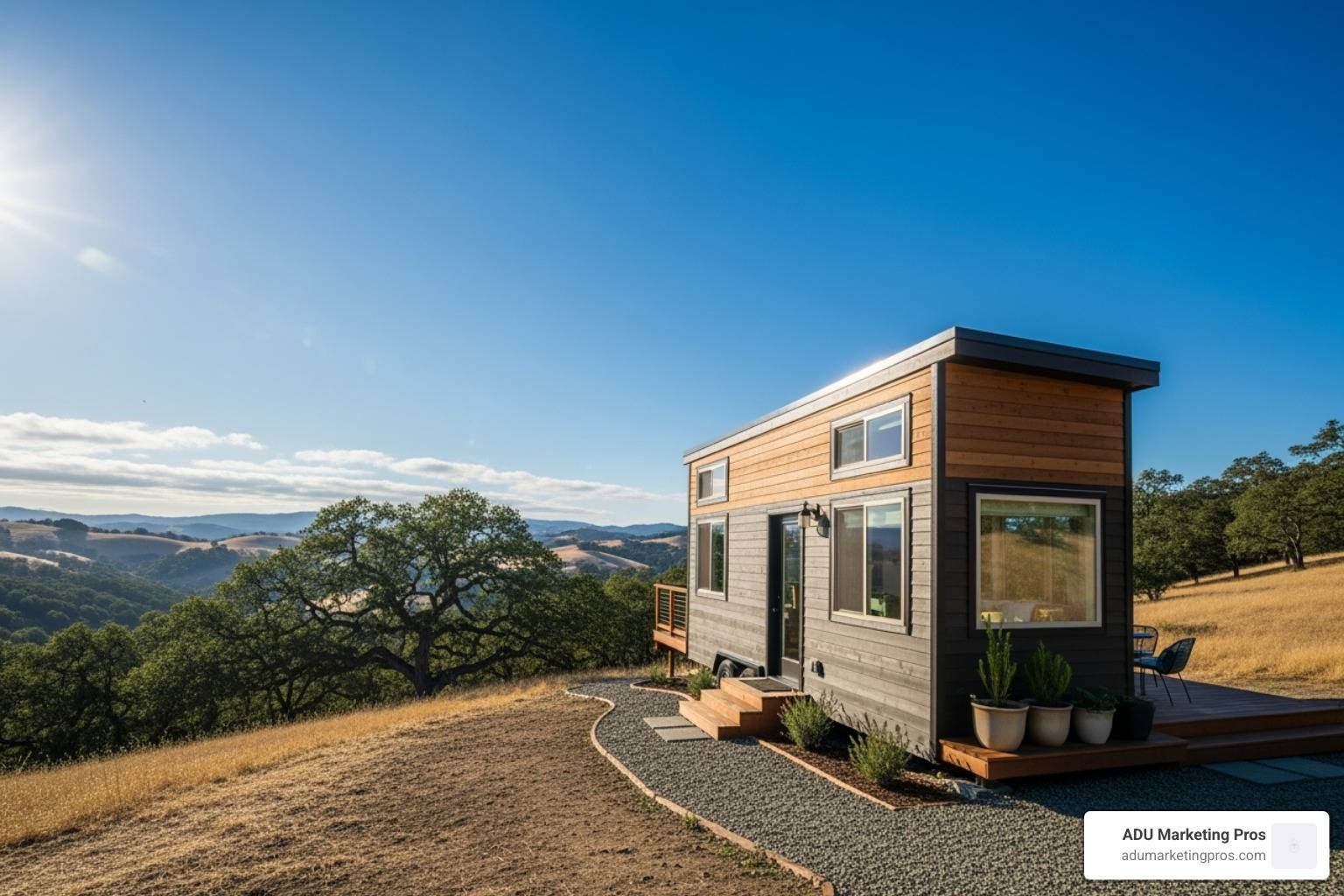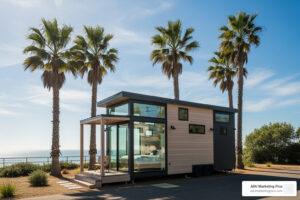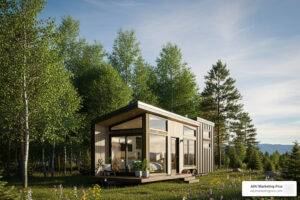Why Building a Tiny Home in California is Both Achievable and Complex
Building a tiny home in california is a popular path to homeownership in a state where housing costs often exceed $800,000. Tiny homes, costing between $30,000 and $100,000, offer a compelling alternative, but navigating the state’s complex regulations is key to success.
California’s regulatory landscape is evolving. The state adopted Appendix Q of the International Residential Code to standardize tiny house construction, and many counties now permit tiny homes as Accessory Dwelling Units (ADUs). However, rules vary significantly by city and county, creating a patchwork of requirements for:
- Foundation Homes: Must meet state building codes.
- Tiny Homes on Wheels (THOWs): Classified as RVs and must meet different standards.
- Zoning & Location: All tiny homes need proper permits and a legally compliant location, with the ADU pathway often being the most straightforward.
As one prospective builder noted, the main challenge is often not how to build, but where you can legally place your home. Fortunately, with over 58 counties allowing some form of tiny home construction, opportunities exist for those who do their research.
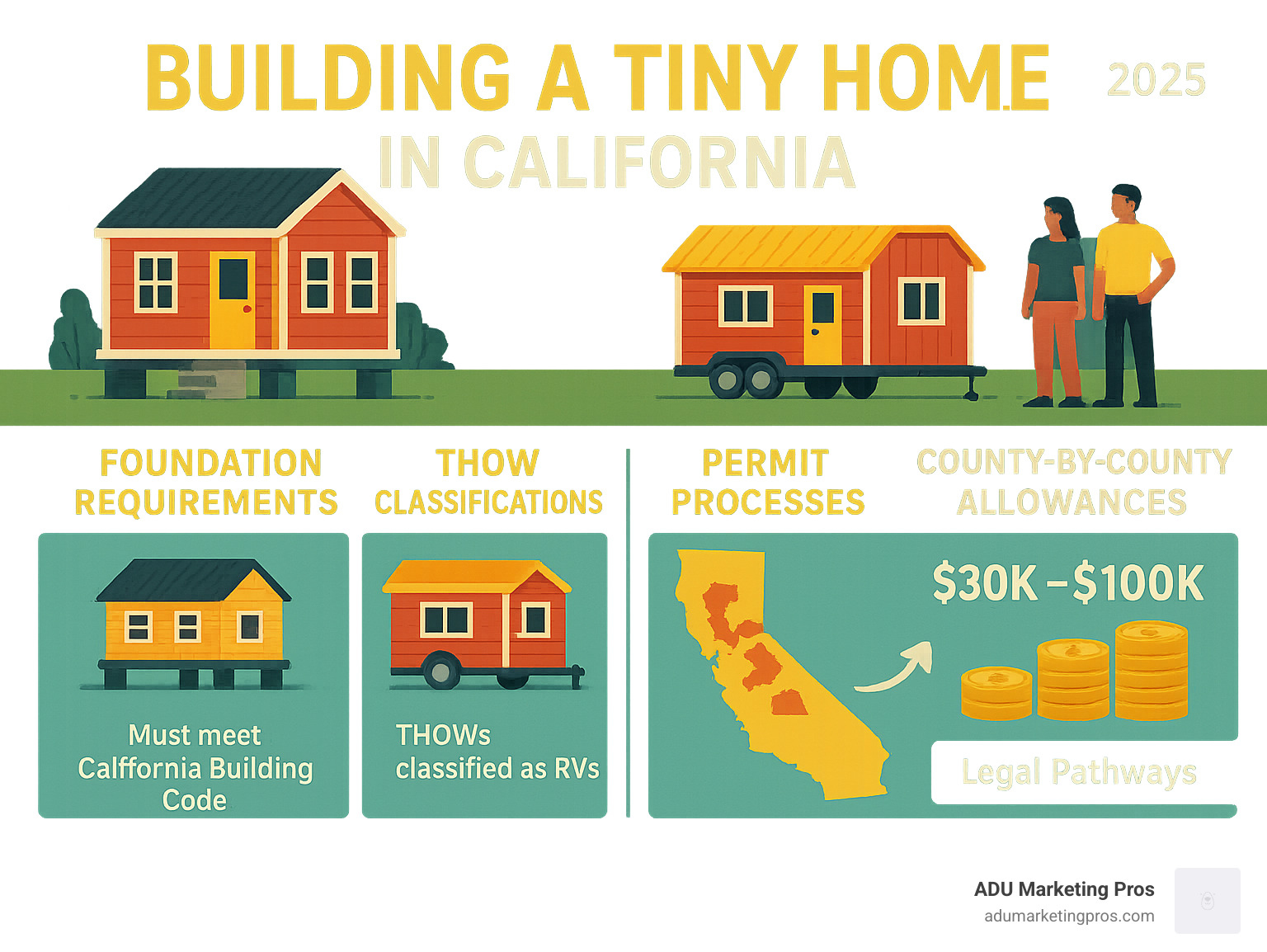
Understanding the Legal Landscape: Is Your Tiny Home Legal in California?
The truth about building a tiny home in california is that there’s no single legal category for “tiny homes.” Instead, your dwelling must fit into an existing classification recognized by the California Department of Housing and Community Development. Understanding these categories is the first step to compliance.
All regulations stem from the 2022 California Building Code, which incorporates Appendix Q, a game-changing addition specifically for tiny houses (under 400 square feet). This appendix provides clear standards for features unique to tiny homes, such as emergency egress requirements, minimum ceiling heights for lofts (often 5 feet), and specifications for stairs and ladders, making it easier for builders to design compliant structures. Understanding these primary legal pathways is the first step to compliance:
-
Site-built homes: A tiny home on a permanent foundation is treated like a traditional house, just smaller. It must meet specific minimums: at least one 120-square-foot room, other habitable rooms of at least 70 square feet, and ceiling heights of 7 feet 6 inches.
-
Accessory Dwelling Units (ADUs): This is often the most welcoming and straightforward path. An ADU is a secondary home on the same property as a primary residence. California’s progressive ADU laws, updated frequently, have dramatically streamlined the permitting process by requiring cities to approve compliant ADUs within 60 days, waiving certain fees, and relaxing parking requirements. This has made it an incredibly popular choice for foundation-based tiny homes, effectively creating new housing stock in existing neighborhoods. For a deeper dive, see our guide on ADU vs Tiny House.
-
Manufactured homes: These factory-built homes conform to federal HUD standards and are placed on a permanent foundation. They are typically larger than what most consider a “tiny home.”
-
Park Model RVs (PMRVs): Built to ANSI A119.5 standards, these units are under 400 square feet and designed for temporary or seasonal use in RV parks. They are licensed with the DMV and are not intended for year-round primary residence in most jurisdictions.
-
Tiny Homes on Wheels (THOWs): These are what most people picture: a home on a trailer chassis. California classifies THOWs as recreational vehicles (RVs), meaning they fall under the Vehicle Code, require DMV registration, and are intended for travel or temporary use.
Each classification follows different rules for construction, permits, and placement. A THOW classified as an RV faces different restrictions than a foundation-based tiny home classified as an ADU.
| Criteria | Tiny Home on Foundation (ADU) | Park Model RV (PMRV) | Tiny Home on Wheels (THOW) |
|---|---|---|---|
| Governing Code | California Building Code (CBC), California Residential Code (CRC) | ANSI A119.5 (Recreational Park Trailer Standard) | California Vehicle Code (as RV) |
| Size Limits | Minimum 120 sq ft main room, 70 sq ft other, 7’6″ ceiling. Max varies by local ADU ordinance. | Typically up to 400 sq ft (excluding lofts). Cannot exceed 14 ft width when towed. | Max 400 sq ft (excluding lofts), 8.5 ft wide, 13.5 ft high for road legality. |
| Mobility | Permanent, affixed to foundation. | Transportable, but designed for stationary use. | Highly mobile, designed for frequent relocation. |
| Taxation | Assessed as real property, subject to property taxes. | Licensed/registered with DMV; personal property tax or vehicle license fee. | Licensed/registered with DMV; personal property tax or vehicle license fee. |
| Occupancy | Permanent residence. | Temporary/seasonal use; some areas allow as ADU on foundation. | Temporary/recreational use; some areas allow as ADU with permit. |
The key takeaway is that your tiny home’s legal classification determines everything. Choose wisely to ensure a smooth path to ownership.
Tiny Homes on Foundations vs. Tiny Homes on Wheels (THOWs)
The choice between a foundation-based home and a Tiny Home on Wheels (THOW) is fundamental when building a tiny home in california. Each path has distinct regulations affecting taxes, financing, and insurance.
Regulations for Building a Tiny Home in California on a Foundation
Tiny homes on permanent foundations are treated as traditional residential structures and must comply with the California Building Code and local zoning. The most common legal route is as an Accessory Dwelling Unit (ADU).
- Legal Status: As an ADU, a tiny home is a permanent residence, subject to property taxes like any other house.
- State Requirements: California mandates specific minimums for habitability, including a 7’6″ ceiling height and at least one room of 120 square feet. For more on state laws, consult the HCD resource on ADUs.
- Financing & Insurance: Financing is similar to a traditional home, often through construction loans or mortgages. Insurance is typically covered under a standard homeowner’s policy.
For more insights into smaller dwellings, check out our page on Small Houses.
Regulations for Tiny Homes on Wheels (THOWs)
THOWs are typically classified as Recreational Vehicles (RVs), designed for mobility and temporary living.
- Legal Status: THOWs must be registered with the California DMV and pay a vehicle license fee. They are considered personal property, not real estate.
- Construction Standards: To ensure safety and legality, many jurisdictions require THOWs to meet the ANSI A119.5 standard for recreational park trailers. Using an RVIA (Recreational Vehicle Industry Association)-certified builder is highly recommended, as it ensures adherence to over 500 safety standards and can ease financing and insurance.
- Occupancy Rules: As RVs, THOWs are generally for temporary use. Many areas restrict occupancy to 180 days per year in one location. However, progressive counties like Santa Cruz now allow permitted THOWs in all zoning districts. Always check local ordinances.
- Financing & Insurance: Financing usually requires an RV loan or personal loan, as traditional mortgages are unavailable. Insurance is provided through an RV policy.
Many THOWs are designed with sustainability in mind. Learn more about Eco-Friendly Small Homes.
The Step-by-Step Process for Building a Tiny Home in California
Building a tiny home in california can be broken down into a manageable, three-phase process: location, permitting, and construction. Following these steps in order is crucial for a successful outcome.
Step 1: Navigating Zoning and Finding a Location
This is where your tiny home dream meets reality. Local zoning ordinances dictate what you can build and where. Your first stop should always be the local planning department in your desired area to get current, accurate information.
- Backyard Placement (ADU): If you own property with an existing home, placing your tiny home as an ADU is often the clearest path. California’s pro-ADU laws have made this option more accessible, but you must still meet local requirements. This includes setbacks (the minimum distance from your property lines), lot coverage limits, and ensuring adequate utility connections. A crucial part of your due diligence is getting a feasibility study or consulting with the planning department to confirm your property can legally and physically accommodate an ADU.
- RV Parks: Many parks across the state welcome tiny homes, especially THOWs and park models. This route provides existing utility hookups and a sense of community but comes with park-specific rules.
- Tiny Home Communities: A growing number of communities are designed specifically for tiny living. Delta Bay community near Sacramento and Tiny House Block in San Diego offer amenities and a communal lifestyle.
For help finding land, especially in Southern California, resources like our guide to Land for Sale in Southern California for Tiny Houses can be a great starting point.
Step 2: Obtaining Permits and Passing Inspections
Once you have a location, the permitting process begins. This is a non-negotiable step for a safe and legal tiny home.
- Building Permits: For foundation-based homes (ADUs), you must submit a full set of detailed construction plans to your local planning department. These aren’t just sketches; they are architectural and structural drawings that prove compliance with every aspect of the California Building Code, from foundation engineering to energy efficiency standards (Title 24). The plan check process can take several weeks or months, and you may be required to make corrections before a permit is issued.
- Utility Permits: Electrical and plumbing permits are typically required to ensure these critical systems meet safety codes.
- Inspections: The permit is not a free pass to build. Throughout construction, a local building official will conduct multiple phased inspections. These are mandatory checkpoints and typically include: foundation and footings (before pouring concrete), framing (before insulation), rough-in for plumbing, electrical, and mechanical systems, and a final inspection. Each inspection must be passed before you can proceed to the next stage, ensuring the home is built safely and to code.
- Certificate of Occupancy: Upon passing the final inspection, you’ll receive a Certificate of Occupancy, the official document declaring your home is legal and safe to live in.
If you need help with design and permitting, consider working with professionals like the Architects in Southern California Who Design Tiny Houses.
Step 3: Choosing Your Builder or DIY Plan

This decision will significantly impact your budget, timeline, and stress level.
- DIY Construction: While tempting for cost savings, building it yourself in California is challenging due to strict building codes and complex permitting. Mistakes can be costly and lead to legal issues if your home isn’t code-compliant.
- Professional Builders: A professional brings expertise, efficiency, and knowledge of local regulations, which can streamline the permitting process. For THOWs, choosing an RVIA-certified builder is a major advantage, as it ensures adherence to safety standards and simplifies approvals.
- Vetting Contractors: Always check a builder’s license, references, and portfolio. Ensure they have specific experience with tiny homes in California.
To find qualified professionals, explore our directory of Tiny House Builders California. The right partner can make your tiny home journey an exciting adventure rather than a stressful ordeal.
Where to Build: Tiny-Home-Friendly Counties and Cities
California’s approach to tiny homes is a patchwork of local ordinances. While the state encourages ADUs, the specific rules for building a tiny home in california depend on your chosen county and city. Doing your homework on local regulations is essential.
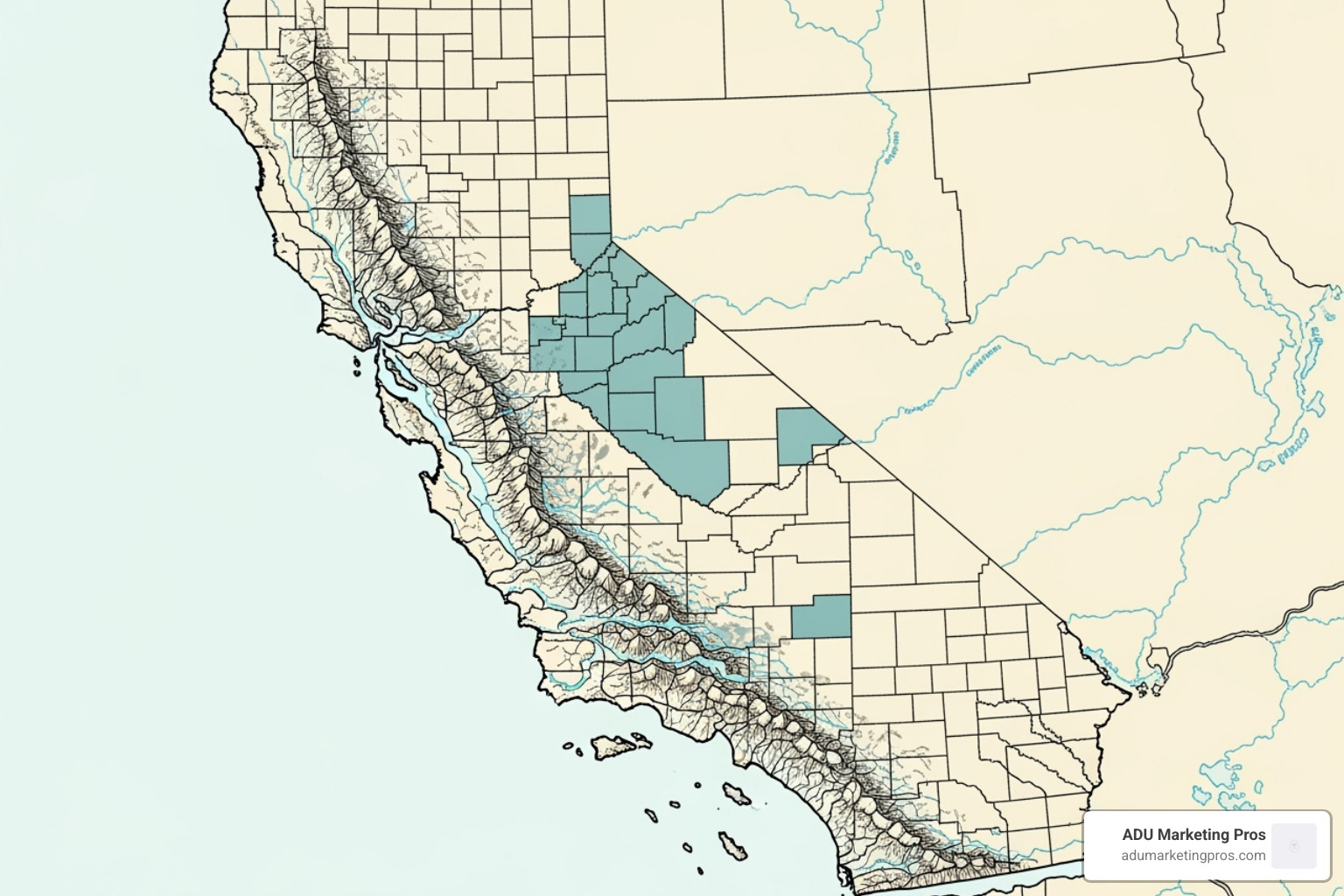
Northern California Hotspots for Building a Tiny Home in California
Several Northern California counties have pioneered flexible housing solutions.
- Fresno County: A trailblazer for transportable tiny homes, allowing dwellings as small as 100 square feet that comply with ANSI standards.
- Sacramento County: The city and county have acceptd tiny homes through progressive ADU provisions and adoption of the 2022 California Building Code.
- Santa Cruz County: Exceptionally welcoming to both foundation homes and THOWs. It allows permitted THOWs in all zoning districts, with clear Rules for Tiny Homes on Wheels in Santa Cruz.
- San Francisco: Despite high costs, the city permits tiny homes that comply with building codes, typically as ADUs. Learn more at Tiny House San Francisco.
Other NorCal counties showing acceptance include Alameda, El Dorado, Humboldt, Marin, Mendocino, Napa, Nevada, Placer, Sonoma, and Yolo.
Southern California Havens
Southern California’s housing needs have also spurred tiny home acceptance.
- Los Angeles County: A leader in the ADU movement, LA County has actively legalized tiny homes as backyard ADUs. The city of Los Angeles, in particular, offers pre-approved ADU plans (“Standard Plans”) to expedite permitting. The county provides clear guidelines for different types of units, including allowing park models to be installed on a foundation and permitted as an ADU, provided they meet health and safety standards.
- San Diego County: A true hotbed for tiny living, the county allows both foundation-based tiny homes as ADUs and THOWs in many zoning districts. Their groundbreaking “Movable Tiny House” information bulletin clarifies the process for legally placing a THOW on a residential property as an ADU, requiring it to be registered with the DMV, connected to utilities, and built to either ANSI or RVIA standards.
- San Luis Obispo County: Permits movable tiny houses as ADUs under specific conditions, offering transparency about building code compliance.
- San Bernardino County: Known for being one of the more affordable areas, this county is open to tiny homes as ADUs under its building and safety regulations.
Other SoCal counties like Riverside, Orange, Imperial, Kern, and Ventura also generally permit tiny homes, though rules vary. For a deeper look, explore Places in Southern California That Allow Tiny Houses.
Always contact the local planning department for the most current information before making any commitments.
The Future of Tiny Living in the Golden State
As California’s housing crisis persists, building a tiny home in california is shifting from a niche lifestyle to a key part of the state’s housing strategy. Legislative changes and a growing focus on sustainability are paving the way for a brighter tiny future.
The state’s aggressive push for Accessory Dwelling Units (ADUs) has created the clearest legal pathway for foundation-based tiny homes by streamlining permits and limiting restrictive local ordinances. Furthermore, California Senate Bill 9 (SB9) allows property owners to split single-family lots, opening up vast new potential for tiny home development to increase housing density.
Sustainability is another major driver. Tiny homes align with California’s environmental goals by using less energy and fewer materials. This reduced footprint makes them an attractive solution for climate-conscious local governments.
Growing acceptance is visible at the county level, with jurisdictions like Santa Cruz and Los Angeles creating specific, welcoming ordinances for different types of tiny homes. This trend is expected to continue, leading to more standardized codes and greater protections for tiny home owners.
As the market matures, the demand for qualified professionals who understand California’s unique regulatory environment is rising. For those looking to build in the Bay Area, resources like San Francisco Tiny House Builders connect homeowners with experienced experts. The convergence of affordability, sustainability, and regulatory evolution ensures tiny homes will play an increasingly vital role in California’s housing landscape.
Frequently Asked Questions about Building a Tiny Home in California
Navigating the rules for building a tiny home in california can be confusing. Here are clear answers to the most common questions.
How small can a tiny home be in California?
The minimum size depends on the home’s classification.
- Foundation Homes (ADUs): The California Building Code requires at least one habitable room of 120 square feet and a minimum ceiling height of 7 feet 6 inches.
- Tiny Homes on Wheels (THOWs): As RVs, there’s no state-mandated minimum interior size, but they are typically under 400 square feet to remain road-legal (8.5 feet wide, 13.5 feet high).
Local ordinances can add other requirements, so always check with your city or county planning department.
Do I have to pay property taxes on a tiny home in California?
It depends on the classification.
- Foundation Homes: Yes. A tiny home on a permanent foundation is assessed as real property, and you will pay annual property taxes on its value.
- THOWs and Park Models: No. Since these are classified as vehicles, you register them with the DMV and pay an annual vehicle license fee instead of property tax. Be aware that long-term placement with permanent utility hookups could potentially trigger a reassessment by a local tax assessor.
Can I place a tiny home on any empty land I own?
Unfortunately, no. Owning land doesn’t grant automatic permission to place a tiny home. Several critical factors come into play:
- Zoning Laws: Most residential zones require a primary dwelling to be built before an accessory dwelling (like a tiny home ADU) can be added. Placing a tiny home as the primary residence on a vacant lot is much more difficult. You would need to find land zoned for such a use, which is rare, or go through a complex and expensive rezoning or variance process. In most cases, a tiny home on a foundation must meet the same requirements as a standard-sized primary home, which may include minimum size requirements that exceed the “tiny” classification.
- Utility Connections: You must have a legal and permitted plan for water, power, and sewage. Connecting utilities to undeveloped land can be complex and expensive.
- Primary vs. Accessory Dwelling: In most areas, a tiny home can only be an “accessory” structure. To make it the primary home on a lot, the zoning must specifically allow it, or you must be in a designated tiny home community.
Before purchasing land or starting a build, consult the local planning and building departments to understand the specific rules for that parcel.
What are the utility requirements for a tiny home?
Utility connections are a critical, non-negotiable part of legalizing your tiny home, whether it’s on a foundation or wheels.
- On-Grid Connections: For any tiny home intended for full-time occupancy (especially ADUs), you must have permitted connections to public utilities: water, electricity, and sewer. This often involves trenching and running new lines from the primary residence or the street, which can be a significant expense. Your plans submitted for permits must include detailed schematics for these connections.
- Off-Grid Systems: While the idea of an off-grid tiny home with solar panels and a composting toilet is appealing, it is much harder to get permitted for full-time, legal residency in most parts of California. Off-grid water (wells) and sewer (septic systems) are heavily regulated by health departments and are often not feasible on small urban lots. Some rural counties may have pathways for this, but it requires extensive research and specialized permits.
Conclusion: Start Your California Tiny Home Journey
Building a tiny home in california is a journey toward a lifestyle of freedom, sustainability, and financial independence. Success hinges on understanding the state’s intricate but navigable regulatory landscape.
Remember these key takeaways:
- Legal classification is everything. Whether you choose a foundation-based ADU or a mobile THOW determines your path for permits, taxes, and placement.
- Local zoning is your guide. State laws provide the framework, but your county and city planning departments have the final say.
- Permits ensure safety. The inspection process, while rigorous, protects your investment and ensures your home is safe and legal.
California’s commitment to solving its housing crisis and promoting sustainability has created a supportive environment for the tiny home movement. By embracing intentional living and a smaller footprint, you can upsize your life in the Golden State.
Ready to find a professional to bring your vision to life? Explore our network of expert Tiny House Builders in California who understand the dream and the details of your project.

